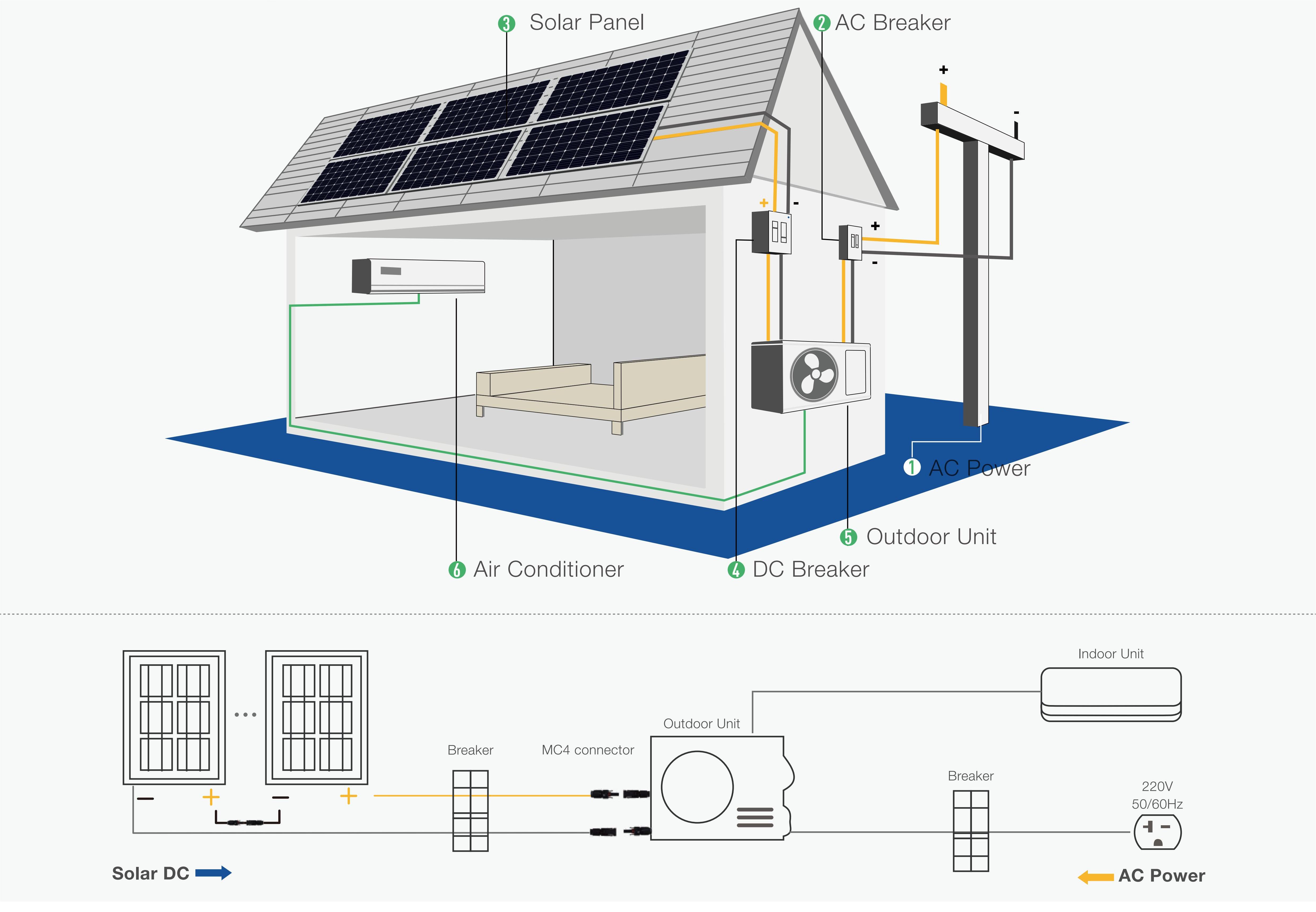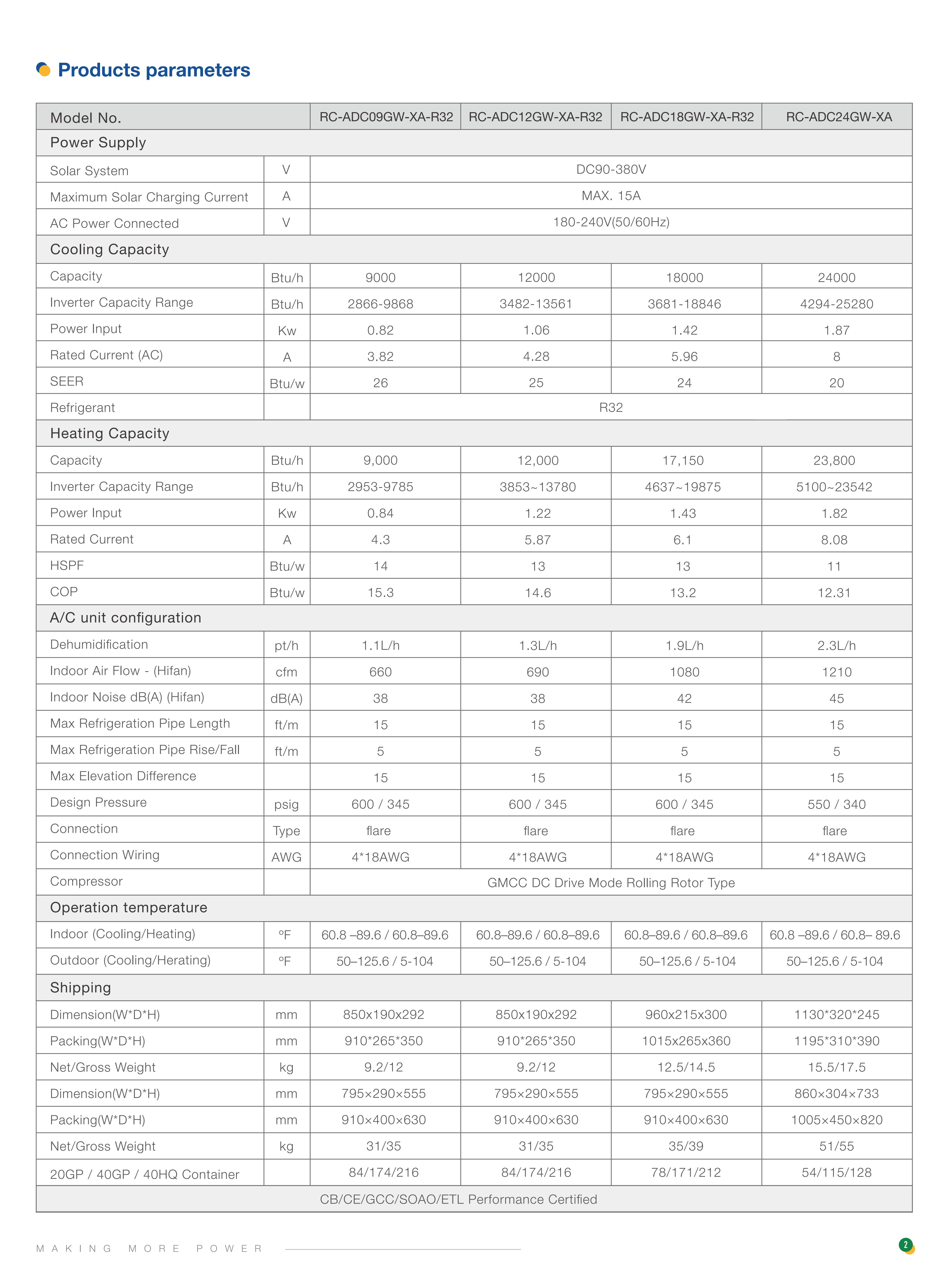a solar-powered air conditioner combines the components of a traditional air conditioning system with a solar power system to reduce reliance on the electrical grid and minimize the environmental impact by utilizing renewable energy sources.
Solar panel voltage:
DC90-380VMaximum Solar Charging Current:
15AAC Power Connected:
180-240V(50/60Hz)Refrigerant:
R32Compressor:
GMCC DC Drive Mode Rolling Rotor TypeConnection:
Flare
A solar air conditioner typically consists of the following components:
Solar Panels: These are used to capture sunlight and convert it into electricity. The solar panels generate the power required to run the air conditioning system.
Compressor: The compressor is responsible for compressing the refrigerant gas, increasing its temperature and pressure.
Condenser: The condenser is a heat exchanger that receives the high-pressure, high-temperature refrigerant gas from the compressor. It releases the heat energy from the refrigerant to the outside environment, causing the gas to condense into a high-pressure liquid.
Evaporator: The evaporator is another heat exchanger that receives the high-pressure liquid refrigerant from the condenser. As the refrigerant flows through the evaporator, it evaporates and absorbs heat from the surrounding air, cooling it down.
Expansion Valve: The expansion valve is a small device located between the condenser and evaporator. It regulates the flow of the refrigerant into the evaporator, reducing its pressure and temperature.
Fan or Blower: The air conditioner has a fan or blower that circulates air over the evaporator, cooling the air and distributing it into the desired space.
Control System: The control system includes sensors, thermostats, and a controller to monitor and regulate the temperature, fan speed, and other settings of the air conditioner.
In a solar air conditioner, the solar panels provide the necessary electricity to operate the compressor and other components, reducing the reliance on grid power. The cooling principle is the same as a conventional air conditioner, where heat is removed from the indoor space and released outside, resulting in the cooling effect.

Here are the basic components commonly found in solar air conditioners:
Solar Panels: Solar air conditioners are equipped with photovoltaic (PV) solar panels that convert sunlight into electricity. These panels are typically mounted on the roof or in a location where they can receive maximum sunlight exposure.
Batteries (Optional): Some solar air conditioners may include battery storage systems to store excess solar energy generated during the day. These batteries can be used to power the air conditioner during periods of low sunlight or at night.
Compressor: The compressor is the main component responsible for circulating the refrigerant and compressing it to create cooling effect. It requires electricity to function, which is supplied by the solar panels or batteries.
Controller/Inverter: Solar air conditioners are equipped with a controller or inverter that regulates the flow of electricity from the solar panels or batteries to the compressor. It ensures the air conditioner operates efficiently and optimizes the use of available solar power.
Regarding the performance of solar air conditioners in bad weather, it largely depends on the system design and the amount of sunlight available. Solar air conditioners can operate on cloudy days, but their efficiency and cooling capacity may be reduced compared to sunny days when more solar energy is available. Some systems may also incorporate battery storage to provide power during periods of low sunlight. It's important to consider the climate and local weather conditions when deciding to install a solar air conditioner and to consult with the manufacturer for specific details on its performance under different weather conditions.

The heating principle of a solar air conditioner can vary depending on the specific design and technology utilized. However, one common approach involves a combination of solar thermal energy and heat pumps. Here's a general explanation:
Solar Thermal Collection: Solar collectors, such as flat plate or evacuated tube collectors, are used to capture solar energy. These collectors absorb sunlight and convert it into heat.
Heat Transfer Fluid: A heat transfer fluid, such as a mixture of water and glycol, is circulated through the solar collectors to capture the thermal energy. The heated fluid carries the captured heat to the next stage.
Heat Absorption: The heated fluid is directed to a heat exchanger located within the solar air conditioner unit. This heat exchanger transfers the heat from the fluid to the air circulating within the system.
Heat Pump Technology: The solar air conditioner incorporates a heat pump which utilizes the absorbed heat to further increase the temperature for effective heating. The heat pump operates by compressing the refrigerant gas, increasing its temperature, and then transferring the heat to the air.
Air Distribution: The heated air is then distributed through ductwork or blowers into the desired space, providing warmth and heating the area.
It's worth noting that there are different types and configurations of solar air conditioners available, each with its unique design, but the basic principle involves capturing solar energy, transferring it to a heat transfer fluid, and then utilizing heat pump technology to heat the air.
FAQs:
Q1: Do you support OEM/ODM?
A:Definitely, OEM&ODM service is supported with a certain quantity,including customize logo,package and label;
Q2: What's the production time?
A: The production time is normally 15 working days. but we will always prepare some stocks for popular models.
Q3: Can you provide DDP service?
A:Yes, if you are a personal customer and don't want to deal with the customs, we can provide DDP service to your address.
Q4: What about the warranty and how to claim?
A: Warranty period are 5 years since you receive the product, our professional after-sales team will deal with all warranty issues.